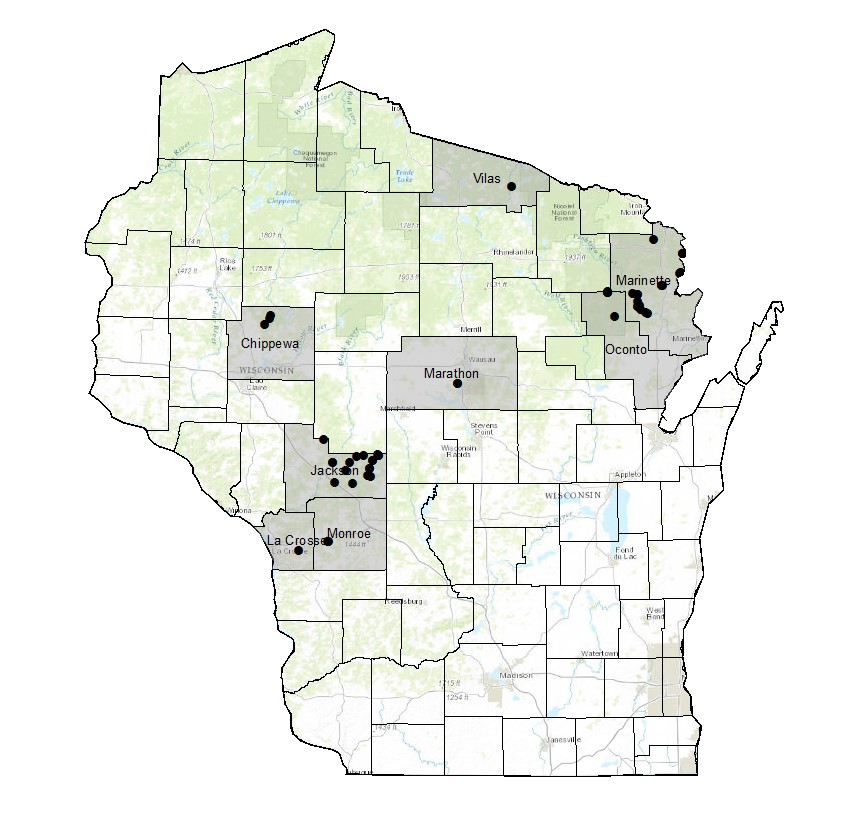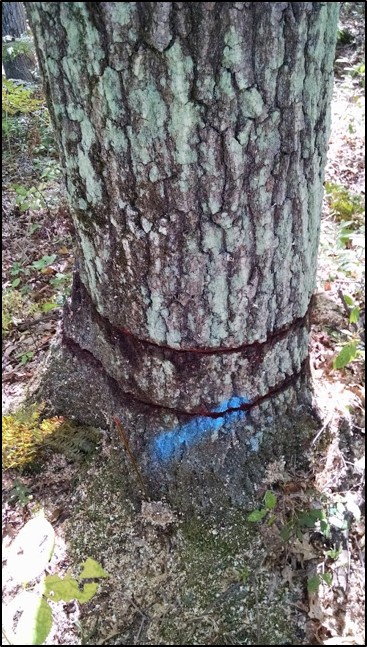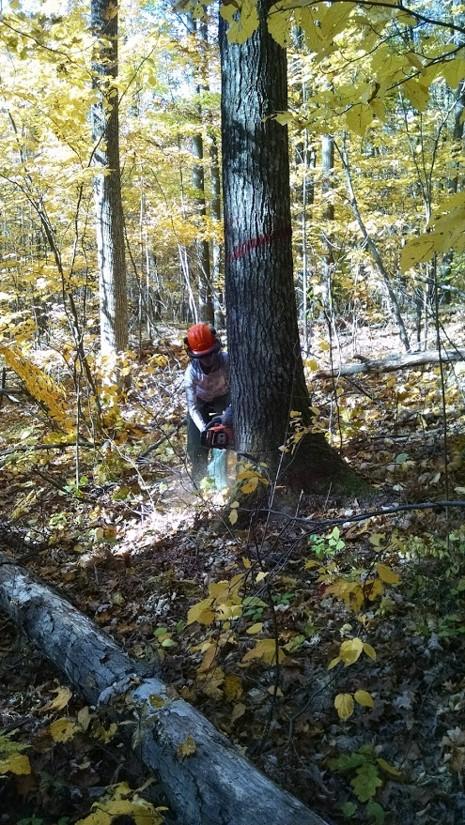Overview

Figure 1: Map of study sites as of 2017
This is an ongoing study that began in 2015 and is expected to wrap up in 2020. There are two major goals of this study; (1) evaluate the effectiveness of girdle-herbicide control of below ground spread of oak wilt disease centers in field applications, and (2) develop operational guidance for the use of girdle herbicide methods of oak wilt control.
The initial study objectives were to include 60 oak wilt pockets, with 50 treatments and 10 controls (five of each type – observation only, or girdle only) in the first two years of the project. In these first two years, we have collected data in 55 pockets (45 treatments and 10 controls), and have monitored 24 treatments and 5 controls from 2015. Sites were chosen based on the stand qualities listed below as well as having relatively sandy soil and flat topography. By following these site restrictions, the study intends to show whether the girdle-herbicide method is still effective, even when conditions are extremely conducive to below ground transfer.
Silviculture Objective(s)
To test a novel approach to oak wilt control in forested settings where traditional treatments are impractical or cost-prohibitive.
Pre-treatment stand description and condition
Pre-treatment species composition:
A composition of >60% red oak group in over-story.
Pre-treatment growth and stocking:
A Basal Area > 35ft2/acre for oaks.
Pre-treatment forest health issues:

Figure 2: Photo of girdle/herbicide treatment.
Oak wilt was present and lab confirmed in all stands included in this study. Ideal sites had only discreet pockets of oak wilt where the edges of pockets could be clearly defined, but in some places, especially Marinette County, oak wilt was much more widespread.
What actually happened during the treatment
Samples were collected and sent in for lab diagnostics (Madison Forest Health Lab) to confirm the presence of oak wilt, since two-lined chestnut borer can be a problem in the study areas. Only pockets with lab-confirmed oak wilt present were used in this study. At each site, a rough determination was made in the field to determine soil texture was appropriate for the study, but soil was also collected and subsequently analyzed for percent sand, silt, and clay. Information regarding understory species and regeneration was also collected at each site.
All symptomatic or infected trees were marked near the base to ensure trees could be identified if harvested. DBH and Lat/Long was recorded for each infected tree (IT). A basal area sweep was performed, with a 10-factor prism, at each IT. The number of “in” trees was recorded, specifying species. The root grafting model developed by Bruhn, Pickens, and Stanfield (1991) was used to determine which trees in the red oak group were likely grafted with infected trees (IT); these trees were considered treatment trees (TT). Root grafting distances were predicted using the sandy soils model for all sites independent of the actual soil texture starting in 2016 due to field and lab soil type discrepancies in 2015. Calculations were done using a 95% confidence interval. All ITs and TTs were stem-mapped and marked with paint in the field. White oaks were stem-mapped, but were not marked or treated.
Each tree (ITs and TTs) was doubled girdled, with the girdles being 6” apart and 3” deep. Girdles were done low on the trees, but forked trees received a double girdle on each stem that was below breast height. A second person followed with an herbicide treatment. The herbicide mix was approximately 12oz of solution (25% Element, 75% diesel) per tree. Herbicide was applied to both cuts with a backpack sprayer.
There were also two types of control sites. The first type (C1) included oak wilt pockets with no treatment, only measurement and observation. The second type (C2) required measuring and girdling only, followed by yearly observations.
Post-treatment assessment
This study is on-going and will continue through the year 2020, at which point true data analysis will be finalized. Below is a brief summary of what has been observed thus far:
24 sites were chemically treated in 2015. By fall of 2017, 9 of the treatments failed to contain oak wilt infection. Of those, 2 showed spread of oak wilt in the first year after treatment, 6 failed to contain infection in the 2nd year after treatment, and 1 showed spread of oak wilt in both years.
20 sites were chemically treated in 2016. Of those, 1 had failed to contain oak wilt by fall of 2017.
6/10 control sites have spread. Of those six, 5 were part of the "observe only" (C1) control group.
Assessment follow-up
Following the completion of the monitoring period, utilizing both girdle and herbicide as containment methods led to an 81% success rate for small pockets of oak wilt, consisting of 4 or fewer trees. For pockets with 5 or more trees, containment success dropped to 29%. This finding suggests the importance of active monitoring and early detection of oak wilt to more effectively contain new pockets.
Plans for future treatments
All pockets will be revisited annually during the summer months (July-August) for five years after initial treatment to look for symptomatic trees. If symptomatic trees are found and confirmed to be infected with oak wilt in the year following the first treatment, they will need to be treated in the same manner as a new oak wilt pocket. Beginning two years after initial treatment, any new spread of oak wilt from the pocket will only be observed, not treated.
In a few cases, some TTs treated with double-girdles and herbicide were found to still be alive one year after they had been treated. In these cases, these trees were re-treated by freshening up the old girdles and adding a fresh, third girdle, and applying herbicide to all three girdles.
Using the data from this project, we will not only be able to ascertain some indication of the efficacy of girdle-herbicide below-ground control of oak wilt, but also net growth loss of red oak with and without treatment and recruitment trends based on size of pocket, soils, and other variables over time. In 2018, in addition to monitoring, we will collect tree regeneration data at random locations within the same stand, and outside of each treatment pocket. This will increase our analytical ability to draw meaningful conclusions about the effects of oak wilt and these treatments on regeneration.
Costs and economic considerations
In our study, the time required to treat oak wilt plots was greater and the amount of chemical we used was less than similar treatments implemented in Marathon County. In 2015 we used on average 1.5 oz./tree versus 3.0 oz./tree reported in Marathon County where County Parks, Recreation and Forestry managers, for example, reported using 6 gallons of mixture in 2011 to treat 71 trees with average diameter breast height (dbh) 13.0 inches. In one of our treatments we used 1 gallon of mixture to treat 151 trees averaging 14.0 inches dbh. In 2016 our average chemical/tree was 2.1 oz, which was greater than that used in 2015, but still below similar management efforts.
One difference could be that we do not saturate bark around the girdles, which may provide little benefit in saw log sized trees. The best predictor we found of the amount of solution required to treat trees within a pocket was the number of treatment trees * DBH though there is variability (P < 0.005, R2 = 0.68).
By recording time to treat pockets as well as stem-mapping all treated stems, we will be able to analyze labor costs for treating these trees, as well as volume losses due to treatment and due to untreated spread of oak wilt in the controls.
Other notes
For a more detailed description of one site treated under this study, check out Oak Wilt Management Through Girdle Herbicide (Marathon Co).
This case study was developed with support from the United States Department of Agriculture's National Institute for Food and Agriculture (USDA-NIFA), Renewable Resources Extension Act (RREA). Project #MIN-44-E02, principal investigator Eli Sagor, University of Minnesota.
Climate Adaptation Considerations
It is generally thought that oaks graft more and depend more on root grafts during drier growing seasons. Drought stress due to climate change may therefore lead to greater spread via root grafts.
Summary / lessons learned / additional thoughts
Following the completion of the monitoring period in 2020, we found the biggest indicator of success or failure when implementing the girdle-herbicide containment treatments was the size of the oak wilt pocket, or number of trees. Pockets with four or fewer newly infected trees had an 81% success rate, while groups of 5 or more had a 29% success rate among containment treatments where the girdle-herbicide method was applied.
